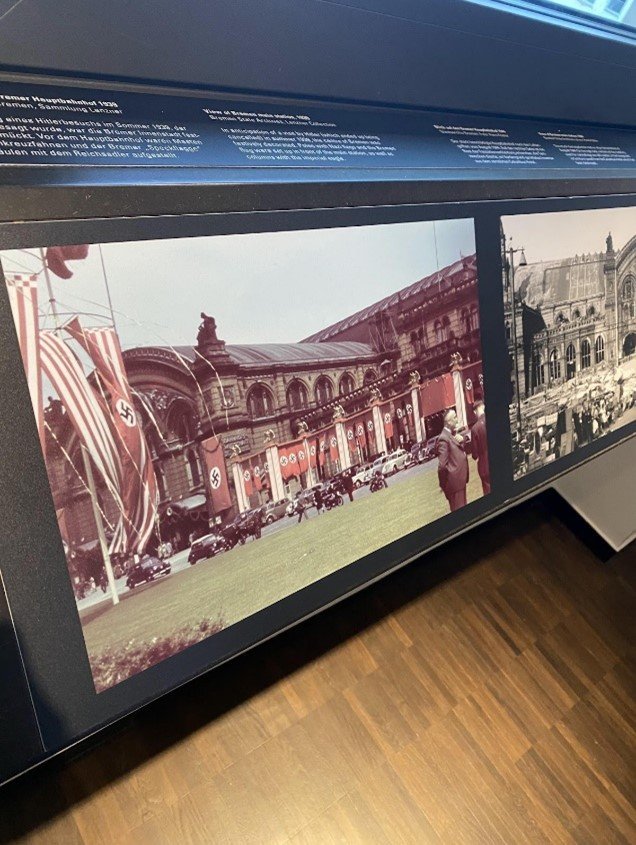Bremen’s Übersee Museum is a must-see for any history buff, as well as people interested in natural history and cultures around the world. It is across from the Bremen Hauptbahnhof (or central train station), just a minute’s walk away. For students, it costs just 3€ for general entry or to the special exhibitions. To view both, it costs 4,50€.
Übersee in German means “overseas,” so this museum has permanent exhibits on various continents and regions such as Oceania, Asia, Africa, and the Americas. Their temporary exhibit currently is, “Young and Wild”, about the lives of animals as they grow up. This is perhaps a bit more suitable for children but as I love animals, I especially enjoyed the videos depicting animals in their natural environment.
There is also a special exhibit running until July 10th about coral reefs, which emphasizes the importance of protecting these ecosystems. It describes the challenges that coral reefs face as well as potential solutions for saving them. If you go, make sure to spend some time doing the coral reef virtual tour as it was both informative and beautiful.

As an American, it was interesting to see aspects of our culture replicated in the Americas exhibit such as the obsession with guns (whether you’re pro or against them!) I especially loved the section devoted to Native American culture and history. It features videos of Native Americans describing their daily life, their culture and how they protect it, and how their community was affected by the settlers and the U.S. government’s irreparable damage.
Another permanent exhibit is called, “What Makes the World Go Round,” which is about various global phenomena such as global economy, sex & gender, migration, and human rights. The last one is the one I have spent the most time in — “Tracking the Past.” It details the history of the museum, as well as the concept and practice of provenance research.
Provenance research is the tracing of the origin of objects. In the context of the museum, it attempts to discover who the original owners of a piece were and under what circumstances did it come to the museum. In the context of colonialism and Nazism, this is crucial for museums in Germany and the Übersee Museum accordingly began their research in 2015. In this exhibit, the museum clarifies how objects originated in a context of injustice, meaning how many of these pieces were stolen or extorted from persecuted people. In my home country, the descriptions of the pieces displayed in museums scarcely mention how they were acquired so for me, this was a completely unique and refreshing approach for a museum to be so self-aware.
A lot of the Übersee Museum’s acquisitions were stolen from native peoples, including bodies that were dug up illegally at night from sacred graveyards. In a recent case in 2017, the museum gave the human remains of up to 40 people, which had been stolen and given back to the Maori and Moriori after 120 years of possession. Unfortunately, this repatriation is not a very common event as the responsibility is upon the people whose objects were stolen to request them back. This can be difficult if there was no record of them being stolen. However, the Bremen Senate does usually honor these requests.
Another fascinating part of this exhibit addresses its development from 1933-1945. A photo, as you can see below, depicts the Bremen Hauptbahnhof and the area surrounding it plastered with swastikas in preparation for a visit from Hitler to the museum (though it never took place).
It is an eerie and shocking sight for me to see the ground I walk on every day, the city that my friends hang out and have fun in, covered in symbols of hatred. As Germany has developed with such astonishing speed from a war-torn country to a progressive, beautiful country, sometimes you forget the horrors that occurred not even 100 years ago in the very place you call home.
The National Socialist senate also sparked a revival of colonial revisionist ideas in Bremen, with some even wanting to call it “the city of the colonies.” As a result, the museum was renamed “the German Colonial and Overseas Museum” in 1935. Remnants of the objects showcased from this time which glorify colonialism can still be seen in part in the “Tracking the Past” exhibit.

When I went on the tour, our guide described to us the debate going on about whether or not it is a good idea to still have these exhibits out. They can foster a dialogue about Bremen’s dark past but for uneducated viewers like children or those who do not read the texts beside the objects, it can send the opposite message than intended. The museum was hit by bombs in World War II and they subsequently redid the building as well as the exhibits inside.
In the post-war era until the present day, the museum has undergone changes in light of decolonisation and social movements to reflect Bremen’s current values. All in all, the attempts the museum has made to highlight and educate on the wrongs they have committed throughout their history is admirable. I appreciated that nearly all of their current exhibits are rooted in today’s cultures or animal life, so the objects are clearly not stolen or misused.
There are certainly two tones within the museum: a more somber one in “Tracking the Past,” and a more colorful and brighter one for most of the rest of the exhibits. No matter where your interest lies, there are exhibits for everyone to enjoy. This is certainly not my last trip to the Übersee Museum and I strongly recommend it for Constructor University's students to get to understand Bremen a bit better and perhaps the rest of the world as well.
BY KENNA ROSALIE HOWORTH (USA) | CLASS OF 2023
